Book contents
- The Cambridge Handbook of Intercultural Communication
- Cambridge Handbooks in Language and Linguistics
- The Cambridge Handbook of Intercultural Communication
- Copyright page
- Contents
- Figures
- Tables
- Contributors
- Acknowledgements
- Introduction
- Part I Introducing Intercultural Communication
- Part II Theoretical Approaches
- 5 Critical Intercultural Communication and the Digital Environment
- 6 From Shared Values to Cultural Dimensions
- 7 Towards Integrative Intercultural Communication
- 8 The Power of Literature in Intercultural Communication
- 9 Psychoanalytic Approaches to Memory and Intercultural Communication
- 10 Sociological Approaches to Intercultural Communication
- 11 Introducing Intercultural Ethics
- Part III Methods
- Part IV Application
- Part V Assessment
- Index
- References
6 - From Shared Values to Cultural Dimensions
A Comparative Review
from Part II - Theoretical Approaches
Published online by Cambridge University Press: 18 February 2020
- The Cambridge Handbook of Intercultural Communication
- Cambridge Handbooks in Language and Linguistics
- The Cambridge Handbook of Intercultural Communication
- Copyright page
- Contents
- Figures
- Tables
- Contributors
- Acknowledgements
- Introduction
- Part I Introducing Intercultural Communication
- Part II Theoretical Approaches
- 5 Critical Intercultural Communication and the Digital Environment
- 6 From Shared Values to Cultural Dimensions
- 7 Towards Integrative Intercultural Communication
- 8 The Power of Literature in Intercultural Communication
- 9 Psychoanalytic Approaches to Memory and Intercultural Communication
- 10 Sociological Approaches to Intercultural Communication
- 11 Introducing Intercultural Ethics
- Part III Methods
- Part IV Application
- Part V Assessment
- Index
- References
Summary
Elizabeth A. Tuleja and Michael Schachner explore a substantial number of very influential contrastive approaches, from Hofstede and the GLOBE study to work by Schwartz, Inglehart and Minkov. The chapter discusses these approaches from both a conceptual as well as a methodological point of view and points out the continued need for multiple perspectives on cross-cultural research in a polycultural world. Rather than opting for an either/or solution, the authors suggest that researchers, educators and practitioners such as communication consultants, want to choose the theory that best suits their needs in a given context.
Keywords
- Type
- Chapter
- Information
- The Cambridge Handbook of Intercultural Communication , pp. 96 - 119Publisher: Cambridge University PressPrint publication year: 2020
References
- 3
- Cited by

